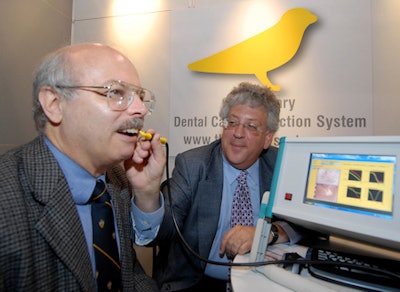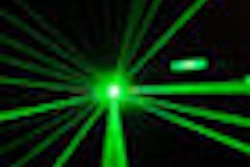
Back in the days before high-tech sensing and monitoring devices, miners used canaries as early warning systems to detect potentially deadly gas leaks in the mines.
Now a Canadian company has developed a laser-based system designed to serve as an early warning system for dental decay.
Laser-based devices for caries detection are not new; commercial devices already on the market or nearing release range from the Diagnodent and D-Carie to quantitative laser fluorescence (QLF) and optical coherence tomography (OCT).
But the Canary system, introduced by Quantum Dental Technologies at the International Association for Dental Research (IADR) meeting in Toronto this month, does something none of the other products do: It combines lasers and thermal imaging to bring the best of both to early caries detection. According to the company, the system is intended to help shift dental care from intervention to prevention by allowing dentists to detect carious lesions earlier -- before drilling and filling are the only options left -- and then use remineralization therapies to reverse the decay.
Using frequency-domain photothermal radiometry (FD-PTR) and modulated luminescence (LUM) technology developed at the University of Toronto, the Canary system scans the teeth with low-power diode laser energy that is absorbed by the teeth. The system measures both the luminescence and the heat released from the tooth to identify the extent of decay. A digital readout indicates the status of a particular area of the tooth.
The temperature rise on the teeth and in the pulp is not more than 2° Celsius.
"An infrared detector captures the emitted thermal radiation and measures how far that heat travels to give information about the deeper regions of the tooth," stated Stephen Abrams, D.D.S., a general practitioner and CEO of Quantum Dental Technologies, in an article in the Canadian Journal of Cosmetic Dentistry. "Low frequencies, about 5 hertz, are deep probes because the heat that is generated pulses up and down very slowly and so it penetrates very deep into the tooth. Whereas high frequencies around 1,000 hertz are shallow probes."
By varying the pulse of the laser, dentists can identify decay as deep as 5 mm from the tooth surface and as small as 50 microns in size. As a lesion grows, there is a corresponding change in the signal; a signal reversal indicates that the remineralization process has started.
Initially, the Canary system was developed for detecting pit and fissure caries, which cannot be detected on an x-ray until there is a large amount of tissue loss, Dr. Abrams stated in an e-mail interview with DrBicuspid.com. When fully developed, the system will be able to scan for caries on smooth enamel surfaces, root surfaces, biting surfaces, between teeth, and around existing fillings.
"In populations exposed to fluoridation, we found that at times the enamel would be intact over the top of a large lesion within the dentin," Dr. Abrams said. "The only indication of a problem was a stained groove or pit, which was really not a diagnostic criteria."
 |
| Dr. Stephen Abrams, CEO of Quantum Dental Technologies (right), and Andreas Mandelis, president, demonstrate a prototype of the Canary system at the IADR meeting. |
"Erosion lesions due to exposure to acidic drinks or gastroesophageal reflux are not visible on radiographs since these are lesions seen on the buccal or lingual surfaces of teeth," he said. "The Canary can monitor ongoing loss of surface hard tissue."
Dr. Abrams stated in the Canadian Journal of Cosmetic Dentistry article that, according to ongoing research, certain dental polishing pastes that become trapped in the occlusal grooves luminesce when exposed to the Diagnodent light, creating a false-positive reading. Plaque, calculus, and composites can also create a false signal, he noted. In addition, QLF sometimes cannot distinguish between caries, stains, and white spots due to fluorosis, and QLF may not be able to detect interproximal lesions deep within the contact area, according to Dr. Abrams.
In a study published in the European Physical Journal - Special Topics (January 2008, Vol. 153:1, pp. 467-469) researchers created demineralized interproximal lesions on extracted teeth by exposing them to a saturated acidic buffer from 6 hours to 30 days. The teeth were examined using PTR and LUM before and after treatment, and radiographs were also taken.
Dental bite wing radiographs showed no signs of demineralization lesions even for samples that had been treated for 30 days. The PTR amplitude, however, increased by more than 300% after 80 hours of treatment.
"PTR [is] a reliable probe to detect early interproximal demineralization lesions," the authors concluded. "Modulated luminescence was also measured simultaneously, but it showed a lower ability to detect these interproximal demineralized lesions than PTR."
At the IADR meeting, Quantum displayed a prototype of the Canary system, which is now in clinical trials that are expected to last for the next 18 to 24 months. If all goes well, commercial release should occur in 2010, with systems selling for $12,000 to $16,000, according to the company. But cost should not be a prohibitive factor, according to Dr. Abrams, because any staff member can be trained to use it, which frees the dentist to focus on other patients and procedures.
"This system allows a dental office to design a patient-based preventive program using dental assistants," he said.
Still, some experts are withholding their final verdict about the system until the clinical trials are complete.
"The concept is very similar to the existing and quite accurate Diagnodent caries-detecting laser in terms of using luminescence," said Donald Coluzzi, D.D.S., chair of the Journal of Laser Dentistry. "I'm very curious how the Canary can seek heat accurately, since it has to deal with saliva and other variables like differences in temperatures in different parts of the mouth -- if you hold your mouth open, for example."
And how does the Canary system compare to OCT?
"OCT gives a three-dimensional picture of tissue, meaning you're not just looking for a cavity on a tooth surface," Dr. Coluzzi said. "It has way more applications in diagnosis ... looking at gum pockets, for example, which is beyond just cavity detection."



















